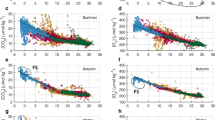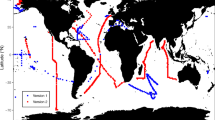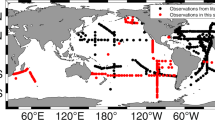Abstract
The biological transformation of dissolved inorganic carbon to organic carbon during photosynthesis in the ocean, marine primary production, is a fundamental driver of biogeochemical cycling, ocean health and Earth’s climate system. The organic matter created supports oceanic food webs, including fisheries, and is an essential control on atmospheric carbon dioxide levels. Marine primary productivity is sensitive to changes due to climate forcing, but observing the response at the global scale remains a major challenge. Sparsely distributed productivity measurements are made using samples collected and analysed on research vessels. However, there are never enough ships and scientists to enable direct observations at the global scale with seasonal to annual resolution. Today, global ocean productivity is estimated using remote-sensing ocean-colour observations or general circulation models with coupled biological models that are calibrated with the sparse shipboard measurements. Here we demonstrate the measurement of gross oxygen production by photosynthesis using the diel cycle of oxygen concentration detected with the array of Biogeochemical-Argo profiling floats. The global ocean net primary productivity computed from this data is 53 Pg C y−1, which will be an important constraint on satellite and general circulation model-based estimates of the ocean productivity.
This is a preview of subscription content, access via your institution
Access options
Access Nature and 54 other Nature Portfolio journals
Get Nature+, our best-value online-access subscription
$29.99 / 30 days
cancel any time
Subscribe to this journal
Receive 12 print issues and online access
$259.00 per year
only $21.58 per issue
Buy this article
- Purchase on Springer Link
- Instant access to full article PDF
Prices may be subject to local taxes which are calculated during checkout



Similar content being viewed by others
Data availability
The profiling float data used in this study were obtained in December 2020 by downloading all Argo Sprof files directly from the Argo Global Data Assembly Center (ftp://usgodae.org/pub/outgoing/argo or ftp://ftp.ifremer.fr/ifremer/argo). The corresponding monthly snapshot (December 2020) of the Argo database, which contains these Sprof files in addition to all floats that do not have biogeochemical sensors, is https://doi.org/10.17882/42182#79118. The Sprof files for floats with adjusted oxygen concentrations were then merged into netCDF files for the Northern and Southern Hemispheres and used for the analyses reported here. These files are available at https://doi.org/10.5281/zenodo.4989023. Monthly satellite data were downloaded from http://www.science.oregonstate.edu/ocean.productivity/.
Code availability
Analyses were performed in Matlab. Code used in this analysis is available at https://doi.org/10.5281/zenodo.4989023.
References
Field, C., Behrenfeld, M., Randerson, J. & Falkowski, P. Primary production of the biosphere: integrating terrestrial and oceanic components. Science 281, 237–240 (1998).
Falkowski, P. G., Laws, E. A., Barber, R. T., & Murray, J. W. in Ocean Biogeochemistry (ed. Fasham, M. J. R.) 99–121 (Springer, 2003).
Falkowski, P. G. The role of phytoplankton photosynthesis in global biogeochemical cycles. Photosynth. Res. 39, 235–258 (1994).
Chavez, F. P., Messié, M. & Pennington, J. T. Marine primary production in relation to climate variability and change. Ann. Rev. Mar. Sci. 3, 227–260 (2011).
Ducklow, H. W., Steinberg, D. K. & Buesseler, K. O. Upper ocean carbon export and the biological pump. Oceanography 14, 50–58 (2001).
Watson, A. J. & Orr, J. C. in Ocean Biogeochemistry (ed. Fasham, M. J. R.) 123–143 (Springer, 2003).
Steinacher, M. et al. Projected 21st century decrease in marine productivity: a multi-model analysis. Biogeosciences 7, 979–1005 (2010).
Bryndum-Buchholz, A. et al. Twenty-first-century climate change impacts on marine animal biomass and ecosystem structure across ocean basins. Glob. Change Biol. 25, 459–472 (2019).
Kavanaugh, M. T. et al. ALOHA from the edge: reconciling three decades of in situ Eulerian observations and geographic variability in the North Pacific Subtropical Gyre. Front. Mar. Sci. 5, 130 (2018).
Barber, R. T. & Hilting, A. K. in Phytoplankton Productivity: Carbon Assimilation in Marine and Freshwater Ecosystems (eds Williams, P. J. L. et al.) 16–43 (Blackwell, 2002).
Steeman Nielsen, E. The use of radioactive carbon (C14) for measuring organic production in the sea. ICES J. Mar. Sci. 18, 117–140 (1952).
Marra, J. A. in Phytoplankton Productivity: Carbon Assimilation in Marine and Freshwater Ecosystems (eds Williams, P. J. L. et al.) 78–108 (Blackwell, 2002).
Marra, J. Net and gross productivity: weighing in with 14C. Aquatic Microb. Ecol. 56, 123–131 (2009).
Fitzwater, S. E., Knauer, G. A. & Martin, J. H. Metal contamination and its effect on primary production measurements. Limnol. Oceanogr. 27, 544–551 (1982).
Koblentz-Mischke, O. J., Volkovinsky, V. V. & Kabanova, J. G. in Scientific Exploration of the South Pacific (ed. Wooster, W.) 183–192 (National Academies Press, 1970).
Luz, B. & Barkan, E. Assessment of oceanic productivity with the triple-isotope composition of dissolved oxygen. Science 288, 2028–2031 (2000).
Juranek, L. W. & Quay, P. D. Using triple isotopes of dissolved oxygen to evaluate global marine productivity. Annu. Rev. Mar. Sci. 5, 503–524 (2013).
Carr, M. E. et al. A comparison of global estimates of marine primary production from ocean color. Deep-Sea Res. 2 53, 741–770 (2006).
Lee, Z., Marra, J., Perry, M. J. & Kahru, M. Estimating oceanic primary productivity from ocean color remote sensing: a strategic assessment. J. Mar. Syst. 149, 50–59 (2015).
Antoine, D., André, J.-M. & Morel, A. Oceanic primary production: 2. Estimation at global scale from satellite (coastal zone color scanner) chlorophyll. Glob. Biogeochem. Cycles 10, 57–69 (1996).
Behrenfeld, M. J. & Falkowski, P. G. Photosynthetic rates derived from satellite-based chlorophyll concentration. Limnol. Oceanogr. 42, 1–20 (1997).
Buitenhuis, E. T., Hashioka, T. & Quéré, C. L. Combined constraints on global ocean primary production using observations and models. Glob. Biogeochem. Cycles 27, 847–858 (2013).
Gregg, W. W. & Rousseaux, C. S. Global ocean primary production trends in the modern ocean color satellite record (1998−2015). Environ. Res. Lett. 14, 124011 (2019).
Westberry, T. K., Behrenfeld, M. J., Siegel, D. A. & Boss, E. Carbon-based primary productivity modeling with vertically resolved photoacclimation. Glob. Biogeochem. Cycles 22, GB2024 (2008).
Saba, V. S. et al. The challenges of modeling depth-integrated marine primary productivity over multiple decades: a case study at BATS and HOT. Glob. Biogeochem. Cycles 24, GB3020 (2010).
Behrenfeld, M. J. et al. Revaluating ocean warming impacts on global phytoplankton. Nat. Clim. Change 6, 323–330 (2016).
Johnson, K. S. Simultaneous measurements of nitrate, oxygen, and carbon dioxide on oceanographic moorings: observing the Redfield ratio in real time. Limnol. Oceanogr. 55, 615–627 (2010).
Nicholson, D. P., Wilson, S. T., Doney, S. C. & Karl, D. M. Quantifying subtropical North Pacific gyre mixed layer primary productivity from Seaglider observations of diel oxygen cycles. Geophys. Res. Lett. 42, 4032–4039 (2015).
Barone, B., Nicholson, D., Ferrón, S., Firing, E. & Karl, D. The estimation of gross oxygen production and community respiration from autonomous time-series measurements in the oligotrophic ocean. Limnol. Oceanogr. Methods 17, 650–664 (2019).
Henderikx Freitas, F., White, A. E. & Quay, P. D. Diel measurements of oxygen- and carbon-based ocean metabolism across a trophic gradient in the North Pacific. Glob. Biogeochem. Cycles 34, e2019GB006518 (2020).
Gordon, C., Fennel, K., Richards, C., Shay, L. K. & Brewster, J. K. Can ocean community production and respiration be determined by measuring high-frequency oxygen profiles from autonomous floats? Biogeosciences 17, 4119–4134 (2020).
Claustre, H., Johnson, K. S. & Takeshita, Y. Observing the global ocean with Biogeochemical-Argo. Annu. Rev. Mar. Sci. 12, 23–48 (2020).
Gille, S. T. Diurnal variability of upper ocean temperatures from microwave satellite measurements and Argo profiles. J. Geophys. Res. 117, C11027 (2012).
Juranek, L. W. & Quay, P. D. In vitro and in situ gross primary and net community production in the North Pacific subtropical gyre using labeled and natural abundance isotopes of dissolved O2. Glob. Biogeochem. Cycles 19, GB3009 (2005).
Quay, P. D., Peacock, C., Bjorkman, K. & Karl, D. M. Measuring primary production rates in the ocean: enigmatic results between incubation and non-incubation methods at station ALOHA. Glob. Biogeochem. Cycles 24, GB3014 (2010).
Ferrón, S., Barone, B., Church, M. J., White, A. E. & Karl, D. M. Euphotic zone metabolism in the North Pacific subtropical gyre based on oxygen dynamics. Global Biogeochem. Cycles 35, e2020GB00674 (2021).
Church, M. J., Lomas, M. W. & Muller-Karger, F. Sea change: charting the course for biogeochemical time-series research in a new millennium. Deep Sea Res. 2 93, 2–15 (2013).
Fawcett, S. E., Johnson, K. S., Riser, S. C., Van Oostende, N. & Sigman, D. M. Low-nutrient organic matter in the Sargasso Sea thermocline: a hypothesis for its role, identity, and carbon cycle implications. Mar. Chem. 20, 108–123 (2018).
Huang, Y., Nicholson, D., Huang, B. & Cassar, N. Global estimates of marine gross primary production based on machine-learning upscaling of field observations. Glob. Biogeochem. Cycles 35, GB006718 (2021).
Silsbe, G. M., Behrenfeld, M. J., Halsey, K. H., Milligan, A. J. & Westberry, T. K. The CAFE model: a net production model for global ocean phytoplankton. Glob. Biogeochem. Cycles 30, 1756–1777 (2016).
Johnson, K. S. & Claustre, H. The Scientific Rationale, Design and Implementation Plan for a Biogeochemical-Argo Float Array (Ifremer, 2016); https://doi.org/10.13155/46601
Kahru, M. Ocean productivity from space: commentary. Glob. Biogeochem. Cycles 31, 214–216 (2017).
Bittig, H., Wong, A. & Plant, J. BGC-Argo Synthetic Profile File Processing and Format On Coriolis GDAC Version 1.21 (Ifremer, 2021); https://doi.org/10.13155/55637
Takeshita, Y. et al. A climatology-based quality control procedure for profiling float oxygen data. J. Geophys. Res. Oceans 118, 5640–5650 (2013).
Johnson, K. S., Plant, J. N., Riser, S. C. & Gilbert, D. Air oxygen calibration of oxygen optodes on a profiling float array. J. Atmos. Ocean. Technol. 32, 2160–2172 (2015).
Bittig, H. C. et al. Oxygen optode sensors: principle, characterization, calibration, and application in the ocean. Front. Mar. Sci. 4, 429 (2018).
Johnson, K. S. et al. Biogeochemical sensor performance in the SOCCOM profiling float array. J. Geophys. Res. 122, 6416–6436 (2017).
Wanninkhof, R. Relationship between wind speed and gas exchange over the ocean revisited. Limnol. Oceanogr. Methods 12, 351–362 (2014).
Riser, S. C. & Johnson, K. S. Net production of oxygen in the subtropical ocean. Nature 451, 323–325 (2008).
Emerson, S. Annual net community production and the biological carbon flux in the ocean. Global Biogeochem. Cycles 28, 14–28 (2014).
Schmechtig, C., Poteau, A., Claustre, H., D’Ortenzio, F. & Boss, E. Processing Bio-Argo Chlorophyll-a Concentration at the DAC Level (Ifremer, 2015); https://doi.org/10.13155/39468
Roesler, C. et al. Recommendations for obtaining unbiased chlorophyll estimates from in situ chlorophyll fluorometers: a global analysis of WET Labs ECO sensors. Limnol. Oceanogr. Methods 15, 572–585 (2017).
Briggs, N., Dall’Olmo, G. & Claustre, H. Major role of particle fragmentation in regulating biological sequestration of CO2 by the oceans. Science 367, 791–793 (2020).
Buesseler, K. O., Boyd, P. W., Black, E. E. & Siegel, D. A. Metrics that matter for assessing the ocean biological carbon pump. Proc. Natl Acad. Sci. USA 117, 9679–9687 (2020).
Morel, A. et al. Examining the consistency of products derived from various ocean color sensors in open ocean (Case 1) waters in the perspective of a multi-sensor approach. Remote Sens. Environ. 111, 69–88 (2007).
Oregon State University Ocean Productivity (Ocean Productivity, 2021); http://www.science.oregonstate.edu/ocean.productivity/
National Geophysical Data Center ETOPO5: Data Announcement 88-MGG-02, Digital Relief of the Surface of the Earth (NOAA, 1988); https://doi.org/10.7289/V5C8276M
Acknowledgements
This work was supported by the Global Ocean Biogeochemical Array project (NSF OCE-1946578; publication no. 1), the Southern Ocean Carbon and Climate Observations and Modeling project (NSF PLR-1425989 and OPP-1936222) and the David and Lucile Packard Foundation. Profiling floats in the equatorial Pacific were supported by NOAA under grant NA16OAR4310161 to the University of Washington. We thank J. Long for assistance with the satellite data, and T. Maurer and J. Plant for processing data and assistance with coding. S. Riser and D. Swift prepared many of the profiling floats whose data were used in this analysis. We thank the Hawaii Ocean Time-series and Bermuda Atlantic Time-series Station programmes for making their data easily accessible. The float data were collected and made freely available by the International Argo Program and the national programmes that contribute to it (https://argo.ucsd.edu, https://www.ocean-ops.org). The Argo Program is part of the Global Ocean Observing System.
Author information
Authors and Affiliations
Contributions
K.S.J. conceived the study, performed final data analysis and drafted the initial manuscript. M.B.B. developed analytical methods and performed exploratory data analyses and contributed to the interpretation of results and writing of the manuscript.
Corresponding author
Ethics declarations
Competing interests
The authors declare no competing interests.
Additional information
Peer review information Nature Geoscience thanks Benedetto Barone and the other, anonymous, reviewer(s) for their contribution to the peer review of this work. Primary Handling Editor: Xujia Jiang.
Publisher’s note Springer Nature remains neutral with regard to jurisdictional claims in published maps and institutional affiliations.
Extended data
Extended Data Fig. 1 Profiling float oxygen data at surface versus time.
Extended Data Figure 1. Profiling float oxygen data at surface versus time. a, Dissolved oxygen and b, Oxygen Anomaly = Oxygen – Oxygen Saturation in the upper 10 m for all adjusted oxygen data with quality flag = 1 (good data) in the Argo Global Data Assembly Center, except for 9 floats listed in Extended Data Table 1.
Extended Data Fig. 2 Global (60°N to 60°S) oxygen and GOP values for the years 2016 through 2020.
Global (60°N to 60°S) oxygen and GOP values for the years 2016 through 2020. a, Mean oxygen anomaly in the upper 20 m from each profile with acceptable cycle timing versus local hour of the day. b, Mean oxygen anomaly in each hourly interval and the least squares fit of equation 2 to the data shown in a) with GOP = 2.1 ± 0.4 (1 Std Error) mmol O2 m−3 d−1.
Extended Data Fig. 3 Annual mean NPP rates from 2010 through 2020 in each 10° latitude band from 50°N to 50°S.
Annual mean NPP rates from 2010 through 2020 in each 10° latitude band from 50°N to 50°S. a, Float and satellite NPP rates versus latitude. b, Satellite NPP rates in each 10° latitude band for each model versus float NPP rates. Satellite NPP models include VGPM21, CBPM24, and CAFE40. All values from Table 1.
Rights and permissions
About this article
Cite this article
Johnson, K.S., Bif, M.B. Constraint on net primary productivity of the global ocean by Argo oxygen measurements. Nat. Geosci. 14, 769–774 (2021). https://doi.org/10.1038/s41561-021-00807-z
Received:
Accepted:
Published:
Issue Date:
DOI: https://doi.org/10.1038/s41561-021-00807-z
This article is cited by
-
Sea of opportunities: marine genomics in an era of global environmental change
BMC Genomics (2023)
-
Zooplankton grazing is the largest source of uncertainty for marine carbon cycling in CMIP6 models
Communications Earth & Environment (2023)



